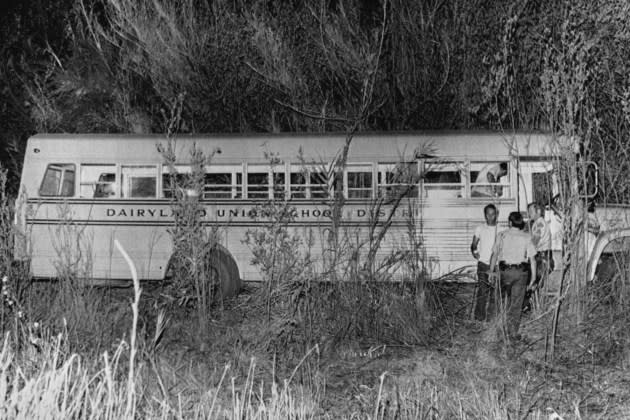‘Chowchilla’: When a School Bus Full of Kids Mysteriously Disappeared

The tale begins with a crime that left everyone baffled. In July 1976, a school bus carrying 26 children (and one driver) was hijacked in the sleepy Central California town of Chowchilla. The kidnap victims were taken to two vans, driven to an abandoned rock quarry, led off the bus, and essentially buried alive in an underground compartment full of mattresses. Things like that just didn’t happen in a town like this.
Seventies California was loaded with bad juju, from the Zodiac Killer to the Patty Hearst kidnapping to Jim Jones. The story told with taste and efficiency in the new CNN/Max documentary Chowchilla wasn’t as big as any of those other descents into madness, but it remains potent, especially as rendered with this level of empathy and depth. This is a hard look at the effects of childhood trauma, crime and punishment, and, on a more life-affirming note, some very tough kids, particularly one 14-year-old who led his friends out of the darkness but never really received his due.
More from Rolling Stone
'Love Has Won': The Deadly Cult Led by the Spirit of 'Robin Williams'
Chuck Lorre on Making Up With Charlie Sheen: 'A Big Weight Off My Heart'
The Dashing Italian Surgeon Who Seduced a Reporter to Mask His Bloody Crimes
Mike Marshall speaks quietly beneath a white cowboy hat of his passion for rodeoing and his memories of that harrowing 36 hours that unfolded some 47 years ago. He’s not really one to toot his horn, but he is the one who literally scratched and dug out of what turned out to be a 27-foot moving van submerged underground. Nobody really gave him credit at the time; the bus driver, Ed Ray, was the grownup on the scene, and he got most of the official plaudits. But the rest of the kids, now adults, make clear that Marshall was the hero.
In subsequent years he plummeted into alcoholism and addiction, haunted by the ordeal, as were many of the others on the bus. Persistent nightmares. Fear of intimacy. Emotional paralysis. Drugs and alcohol. The psychiatrist and trauma expert who worked with the kids at the time, Lenore C. Terr, explains in a current interview that the Chowchilla kids were unknowing pioneers of sorts, childhood trauma victims at a time when research in that field hadn’t evolved to its current state. Today, counselors arrive immediately in the wake of, say, mass shootings. Back then, the Lions Club paid for the kids to go to Disneyland, figuring a trip to the happiest place on Earth would set them right.
There’s also a manhunt for the three perpetrators, which didn’t take terribly long. As you watch the first half of Chowchilla, assuming you’re going in cold, you keep asking: Who did this, and why? The answers are unexpected. The ringleader, Frederick Woods, was a rich young man; his family owned the Magic Mountain amusement park. He was just a twerp who wanted some money of his own and saw a $5 million ransom demand as his ticket. It seems he and his cohorts wanted to make a movie inspired partly by Dirty Harry, the climax of which finds a psycho hijacking a school bus and taking it to a rock quarry. The three inevitably went to prison, but another subplot emerges as they become eligible for parole, and the surviving kidnap victims fight to keep them behind bars.
Director Paul Solet makes expert use of archival media, especially TV news accounts of the story that capture the times and the texture, the initial bewilderment at what could have possibly happened to a disappeared school bus full of kids, and then the forced celebratory tone upon their return. He also commits to extensive, well-acted recreations, in which the child actors don’t speak and don’t have to — the looks on their faces say it all. The current interviews also pack a punch. As Larry Park recounts what happened, and what the subsequent years have been like, he looks down and recoils as if reliving the events all over again. This, of course, is trauma in a nutshell. Eventually, Park became a pastor, to save his own soul as much as his psyche. As he puts it, “God forgive them, because I can’t.” And yet, eventually, he does.
Chowchilla is a work of sturdy, sensitive documentary filmmaking, devoid of glitz, exploitation or sensationalism. It’s a worthy monument to a group of kids taken on a detour that would shape the rest of their lives, and a vivid time capsule of strange, troubling times.
Best of Rolling Stone
